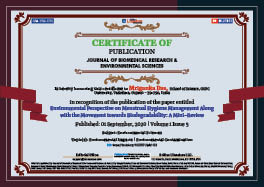Isita Ghosh, Dhaivat Rakholia, Keyur Shah, Disha Bhatt and Mriganka Das*
Volume1-Issue5
Dates: Received: 2020-08-13 | Accepted: 2020-08-30 | Published: 2020-09-01
Pages: 122-126
Abstract
The topic indicated in this mini-review is an essential factor for the improvement of society through a clean environment movement. Now, this era of microbes forces us to make such kind of development for creating hazard free and healthy life. Girls in rural areas use old cloths, tissue paper, cotton, wool pieces, or a combination of these items to manage menstrual bleeding. Qualitative studies indicate that only those girls who know about several conventional sanitary pads, they prefer to use it. But for many girls, such pads are unavailable or unaffordable. These pads, when flushed, swell up due to saturation with liquid results in sewage blockage, which is a global problem. Sanitary products with the blood of an infected woman/girl may contain hepatitis and HIV viruses where pathogens can live up to 6 months and will retain in soil/water bodies. Incineration is a technique to dispose of menstrual waste. But the burning of pads releases gases that affect health and environment, where the chemical dioxins are toxic and carcinogenic. Considering this drawback, biodegradable sanitary napkins made from natural fibers are a perfect alternative route creating a hazard-free environment. This article focus on the development of different biodegradable sanitary napkins that are made up of the fiber of different plasnts like jute, banana, cotton, water hyacinth bamboo etc. This development provides infection and irritation-free menstruation using bio-active materials of plant origin, which also possess anti-microbial properties. The final implementation of this product will also benefit society by employing rural women empowerment.
FullText HTML
FullText PDF
DOI: 10.37871/jels1129
Certificate of Publication

Copyright
© 2020 Ghosh I, et al. Distributed under Creative Commons CC-BY 4.0
How to cite this article
Ghosh I, Rakholia D, Shah K, Bhatt D, Das M. Environmental Perspective on Menstrual Hygiene Management Along with the Movement towards Biodegradability: A Mini-Review. J Biomed Res Environ Sci. 2020 Sep 01; 1(5): 122-126. doi: 10.37871/jels1129, Article ID: jels1129
Subject area(s)
University/Institute
References
- Thakre SB, Thakre SS, Reddy M, Rathi M, Pathak KUS. Menstrual Hygiene: Knowledge and practice among adolescent school girls of saoner, Nagpur District. J Clin Diagonostic Res. 2011; 5: 1027-1033. https://tinyurl.com/y6rlvj7y
- Diaz A, Laufer MR, Breech LL. Menstruation in girls and adolescents: Using the menstrual cycle as a vital sign. Pediatrics. 2006; 118: 2245-2250. https://tinyurl.com/y2qc45m9
- Bagga A, Kulkarni S. Age at menarche and secular trend in Maharashtrian (Indian) girls. Acta Biol. Szeged. Acta Biol Szeged. 2000; 44: 53-57. https://tinyurl.com/y5e3mgnt
- Kaur R, Kaur K, Kaur R. Menstrual Hygiene, Management, and Waste Disposal: Practices and challenges faced by girls/women of developing countries. J Environ Public Health. 2018. DOI: 10.1155/2018/1730964
- Ahuja M. Age of menopause and determinants of menopause age: A PAN India survey by IMS. J Midlife Health. 2016; 7: 126. DOI: 10.4103/0976-7800.191012
- Tjon A Ten. Menstrual hygiene : A neglected condition for the achievement of several Millennium Development Goals : IRC. Eur Extern Policy Advis. 2007: 22. https://tinyurl.com/yy2cufz2
- Bhor G, Ponkshe S. A Decentralized and Sustainable Solution to the Problems of Dumping Menstrual Waste into Landfills and Related Health Hazards in India. Eur. J Sustain Dev. 2018; 7: 334-344. DOI: https://doi.org/10.14207/ejsd.2018.v7n3p334
- Liu Y, Hu H. X-ray diffraction study of bamboo fibers treated with NaOH. Fibers Polym. 2008; 9: 735-739. https://tinyurl.com/y6r7rdn9
- Erdumlu NOB. Investigation of regenerated bamboo fibre and yarn characteristics. Fibres Text. East Eur 2016; 4: 43-41.
- Wang G, Chen F. Development of bamboo fiber-based composites. Adv. High Strength Nat. Fibre Compos. Constr. Elsevier Inc. 2017: 235-255. DOI: https://doi.org/10.5897/SRE2018.6580
- Sekerden F. A study on comparison of air permeability properties of bamboo / cotton and cotton towels. Sci Res Essays. 2018; 13: 143-147. https://tinyurl.com/y49jvd22
- Bouwman AF. Nitrogen oxides and tropical agriculture. Nature. 1998; 392: 866-867. https://tinyurl.com/y49jvd22
- Abera-Kalibata AM, Gold CS, Van Driesche RG, Ragama PE. Composition, distribution, and relative abundance of ants in banana farming systems in Uganda. Biol Control. 2007; 40: 168-178. DOI: https://doi.org/10.1016/j.biocontrol.2006.11.006
- Deepa B, Abraham E, Cherian BM, Bismarck A, Blaker JJ, Pothan LA, et al. Structure, morphology and thermal characteristics of banana nano fibers obtained by steam explosion. Bioresour Technol. 2011; 102: 1988-1997. DOI: https://doi.org/10.1016/j.biortech.2010.09.030
- Alavudeen A, Rajini N, Karthikeyan S, Thiruchitrambalam M, Venkateshwaren N. Mechanical properties of banana/kenaf fiber-reinforced hybrid polyester composites: Effect of woven fabric and random orientation. Mater Des. 2015; 66: 246-257. DOI: https://doi.org/10.1016/j.matdes.2014.10.067
- Venkateshwaran N, Elayaperumal A. Banana fiber reinforced polymer composites - A Review. J Reinf Plast Compos. 2010; 29: 2387-2396.
- Boopalan M, Niranjanaa M, Umapathy MJ. Study on the mechanical properties and thermal properties of jute and banana fiber reinforced epoxy hybrid composites. Compos. Part B Eng. 2013; 51: 54-57. DOI: https://doi.org/10.1016/j.compositesb.2013.02.033
- Chonsakorn S, Srivorradatpaisan S, Mongkholrattanasit R. Effects of different extraction methods on some properties of water hyacinth fiber. J Nat Fibers. 2019; 16: 1015-1025. DOI: https://doi.org/10.1080/15440478.2018.1448316
- Shahzad A. Hemp fiber and its composites - a review. J Compos Mater. 2012; 46: 973-986. DOI: https://doi.org/10.1177/0021998311413623
- Rana AK, Mandal A, Mitra BC, Jacobson R, Rowell R, Banerjee AN. Short jute fiber-reinforced polypropylene composites: Effect of compatibilizer. J Appl Polym Sci. 1998; 69: 329-338. DOI: https://doi.org/10.1002/(SICI)1097-4628(19980711)69:2<329::AID-APP14>3.0.CO;2-R
- Gibeop N, Lee DW, Prasad CV, Toru F, Kim BS, Song J Il. Effect of plasma treatment on mechanical properties of jute fiber/poly (lactic acid) biodegradable composites. Adv Compos Mater. 2013; 22: 389-399. DOI: https://doi.org/10.1080/09243046.2013.843814






























































